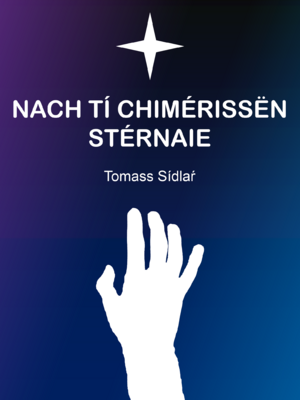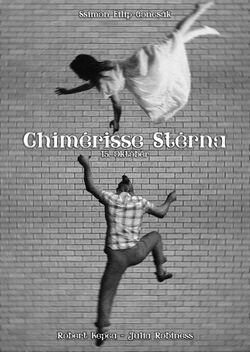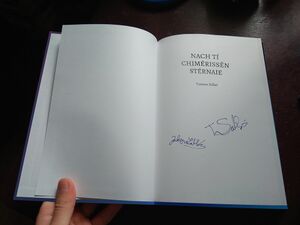Following the Chimeric Star: Difference between revisions
m (→Plot summary) |
m (→Illustrations) |
||
| Line 125: | Line 125: | ||
{{Main|Jakov Sídlaŕ}} | {{Main|Jakov Sídlaŕ}} | ||
The original edition, as well as most of the following editions of the book, include a set of 13 illustrations made by [[Jakov Sídlaŕ]]. Those 13 illustrations are trying to symbolically expand onto the storyline outlined by words. It applies of lot of symbolism, always keeping the blue-black-purple gradient, with a number of white silhouettes in some situation. A notable amount of minor details is included. | The original edition, as well as most of the following editions of the book, include a set of 13 illustrations made by [[Jakov Sídlaŕ]]. Those 13 illustrations are trying to symbolically expand onto the storyline outlined by words. It applies of lot of symbolism,{{efn|A lot of the symbolism revolves about religious concepts. Undeniably mentioned religions include [[wikipedia:Christianity|Christianity]], [[wikipedia:Buddhism|Buddhism]] and [[wikipedia:Islam|Islam]]}} always keeping the blue-black-purple gradient, with a number of white silhouettes in some situation. A notable amount of minor details is included. | ||
Used symbolism includes [[wikipedia:Ball and chain|ball and chain]] as a metaphor to a job one does not enjoy (as it was used in many countries during forced prison labor), reference to the [[wikipedia:The Creation of Adam|''The Creation of Adam'']], using its symbolism in a metaphorical way to connect the death of Petŕ to the act of life being given. | Used symbolism includes [[wikipedia:Ball and chain|ball and chain]] as a metaphor to a job one does not enjoy (as it was used in many countries during forced prison labor), reference to the [[wikipedia:The Creation of Adam|''The Creation of Adam'']], using its symbolism in a metaphorical way to connect the death of Petŕ to the act of life being given. | ||
Revision as of 12:16, 9 July 2022
 Original cover of the 1988 edition | |
| Author | Tomass Sídlaŕ |
|---|---|
| Original title | Nach tí Chimérissën Stérnaie |
| Illustrator | Jakov Sídlaŕ |
| Cover artist | Jakov Sídlaŕ |
| Country | |
| Language | Walnerian |
| Genre | Psychological fiction |
Publication date | 12 May 1988 |
Published in Anglish | 7 November 1992 |
| Pages | 214 (Walnerian)[a] 226 (Anglish)[b] |
| Website | www.chimeric-star.wn |
Following the Chimeric Star (Walnerian: Nach tí Chimérissën Stérnaie) is a 1988 novel written by the Walnerian screenwriter and journalist Tomass Sídlaŕ. It is written using the first-person narrative mixed with few moments, where the third person omniscient subjective is used. It is set in the "present day", as no year is mentioned and the book is kept vague to make it feel like it may be happening at any time. The illustrations, always using a dark blue - purple gradient with white silhouettes on it, were drawn by the author's brother Jakov Sídlaŕ.
Characters
The main character is the 19-year-old Petŕ Junek, a student, who is seeking a refuge from the stress with a female character referred to only as a "Star" (with a capital S). Star is a young woman which is described only in metaphors, at least through the eyes of Petŕ. Minor characters of the story are Petŕ's father (who remains unnamed), Petŕ's teacher (who also remains unnamed) and Petŕ's group of two friends (which are referred to only by nicknames Kurys and Globi, however, Kurys's surname was mentioned to be "Kuriáss").
Personalities
- Petŕ[c] (Sometimes translated as Peter) - Melancholic introverted 19-year-old, who struggles with school and has the tendency to give up a fight before it even begins
- Star (Sometimes kept with the original name Stérna[d]) - Young female (about the age of Petŕ), described as spontaneous and highly likeable, however, she has the tendency to be highly responsible and extroverted
- Petŕ's father - Strict and conservative parent, who projects his own ideals onto Petŕ, even though Petŕ does not share his world-view
- Petŕ's teacher - Strict but fair old male, who seeks to push his students through the final exam, even though he realizes that some do not have the required skills
- Kurys & Grobi - Highly spontaneous extroverted 20-year-olds who share a hedonistic world-view
Plot summary
Introduction

The plot of Following the Chimeric Star[e] begins with Petŕ being told by his teacher, that he failed the Matura[f] and is asked to come back in September (5 months from then), to try to re-take it. After that, Petŕ, being in a state of shock and not being able to comprehend the reality at hand, leaves for home. At home, he is scolded by his father, who holds a long speech about Petŕ being too lazy to work for his future, saying, that he does not deserve one. As a final note, he is grounded for a week, with everything but his study material taken away. He is also reminded, that he has a three-week-long part-time job that is supposed to show him, what manual labor means. In the evening, after eating dinner, his father locks him in a bedroom and goes downstairs, being too angry to speak to him.
The book skips to him sitting in the park at night, after which a girl comes and sits next to him, she is introduced in a dialogue as a "Star". They talk for a while, and he tells her, that he failed the exam and is down, she tries to lift him up and tries to relax him through the idea of a second chance in September. They proceed to leave the park and go to an unspecified place, known only by Star.
The next morning, Petŕ is tired, and his father is giving him the silent treatment. TV is running a newsreel about an economic recession and father is eating a large bowl of müssli. Petŕ spends the day in his room, looking over walls and ceiling, sometimes opening one of the many books that he has been left with in order to study, however, he can not get his mind to concentrate on the subject at hand. In the evening, he is no longer locked in the room. Again, there is a cut and Petŕ is sitting next to Star on a cliff over a city, excusing himself for the delay. They speak for a little while, getting to know each other. She reveals few things about herself outside of her mentality, keeping the idea of mysterious personality.
Setup

During the next few chapters, this cycle repeats with multiple changes, such as his father slowly getting less angry and trying to normalize the relation between him and his son, and his friends asking him if he wants to sneak out for some party. Each meeting with Star creates a stronger bond between Petŕ and Star. Eventually, on the seventh meeting, Petŕ asks if he could stay for longer. Star says, that she can not affect his life, it is up to him to pull himself up by the bootstraps and to get his ducks in row. She then asks if she is distracting him from his problems, if she is "only a plaster on his wounds". Petŕ denies this and tells her he loves her. She nods and whispers, that she loves him, too. They reach for a kiss, however, their lips don't touch.
A major change happens, when there is no intentional book cut, and it is revealed, that Star is living only inside of Petŕ's head, as after this dialogue, he wakes up to an alarm. He feels depression over him not being a second faster. The next few days, it comes clear, that his father is getting worried about him apparently losing the will to do anything and asks if everything is alright. Petŕ confirms, that everything is fine and goes to bed, even though it is afternoon. His father runs up the stairs and asks him why he is sleeping a lot. Petŕ, realizing, that he has no chance of explaining it to his father, says, that he is just tired of all the studying. To this, his father smiles and says, that he sleeps more than studies.
Gradation

The day of the part-time job rolls around and Petŕ is forced to carry heavy boxes for below the minimal wage[g] in the heat of the noon sun for three weeks. After coming home, he simply falls asleep, giving him more time for Star. He has taught himself, that Star's world is the only one pleasant, developing a positive feedback loop of negativity and defeatism, which results in his escapist tendencies escalating. His friends try to convince him to go hang out (like two times before, he has gone out with them in the book), but he refuses. The story escalates when he completely gives up studying and starts taking sleeping pills to spend more time with Star.
Star is slowly realizing something is wrong. She is still very friendly and does her best to support Petŕ in the struggle he is stuck in, but eventually asks, what has happened. Petŕ replies, that he hopes he could join her forever, which she vehemently refuses and asks him why he wants to do that. He replies, that this is way better life than the one he has been served, gesturing at the small farm with horses and sheep they are watching from the hilltop. She smiles and tells him, that she loves him, and that she wishes him only the best, upon which she asks him to please get his life in order, for her, as it hurts her as much as him. He nods.
As the end of August approaches, Petŕ is struggling hard to get a grasp on the subject he has failed in the first matura and spends a lot of time to get the required general knowledge to pass. At night, Star is giving him the much-needed emotional validation which the outer world failed to offer him. Once Petŕ realizes he is stuck in a loop of self-harm, he tries to open to his dad about the existence of Star. His father refuses to believe it and calls him crazy, saying, that "he better not try giving him this bullshit and better get a life".
Climax
Broken, Petŕ tries to spend his last few days before the exam memorizing the most complicated parts of the subject. Star seems to understand the tension he is in and tries her best to provide him with the much-needed comfort the outer world was designed to deny him. As the day of the matura comes, Petŕ prays for the best. Unfortunately for him, his teacher was in a bad mood that day and made him pick the most complicated question, which he falls short of by a small margin. Failing for the second time and being faced with a prospect of losing any hope in the future, Petŕ goes to sleep to ask Star what exactly is he supposed to do, only to find out, that she is nowhere to be found.
Fearing he failed her, he decides that he may need to go deeper into his dreams to find her. He takes all the sleeping pills at the same time, along with multiple painkillers, hoping that this would give him the kick he needs to see Star once again. The drugs had multiple active agents which acted against each other, and Petŕ died of overdose at the age of 19. The book ends with a first-person shot of Petŕ reaching his hand for Star, as she reaches her hand back, both engulfed in a complete darkness of an afterlife antechamber.
Interpretation
It is suggested, from multiple interviews with Tomass Sídlaŕ, that the whole book is a metaphor for a clash of the perceived world, values, reasoning and priorities of a person with autism and the society's perceived world, values, reasoning and priorities at large. This idea may be backed with the fact, that Tomass Sídlaŕ has been diagnosed with Asperger syndrome at age 9.
Alternate interpretation is, that the book is referring to a set of ideas and feelings in the heart of a child, that is unwillingly pushed to grow up and emotionally mature by its parents at too young age, being forced to face consequences for something that is not under its control.
The character of Star, and the dream world at large, may be a metaphorical representation of the world-view that is threatened by the consensus of the society, which does not respect minority opinions and world-views and is trying to enforce uniformity of moral values.
Reception
The book was originally met with mixed reception, with multiple famous authors calling it a parody of a literature, or noting its partial similarity to the book The Sorrows of Young Werther. However, in the early 1990s, the generation of people between 20th and 40th year of age, which have gone through the standardized matura exams, found this book inspiring and creative, getting its re-publishing in 1995 to the top of bestseller lists in Walneria.
Irony
In the 2009 revision of the Matura Literature Canon, which is a set of books from which students can pick books for their Matura in literature, Following the Chimeric Star has been included. Tomass Sídlaŕ noted, that his is a rather ironic twist, as if even a single student fails the exam by picking this book, the story of fiction, which was meant to refer to a corrupt society hunting for success will turn into a story, that happened in reality.
Illustrations
The original edition, as well as most of the following editions of the book, include a set of 13 illustrations made by Jakov Sídlaŕ. Those 13 illustrations are trying to symbolically expand onto the storyline outlined by words. It applies of lot of symbolism,[h] always keeping the blue-black-purple gradient, with a number of white silhouettes in some situation. A notable amount of minor details is included.
Used symbolism includes ball and chain as a metaphor to a job one does not enjoy (as it was used in many countries during forced prison labor), reference to the The Creation of Adam, using its symbolism in a metaphorical way to connect the death of Petŕ to the act of life being given.
One of the most reocurring metaphors both in text and in illustrations are clocks standing for Apocalypse, both in the old interpretation of disclosure (as the alarm going off would mean waking up and reminding Petŕ of what the real world is) and the new of ending something (as ripping him away from Star, which to him is more important than the real world).
Another metaphors include horses standing for a higher power (or predestination, depending on interpetation), streets standing for any path in life and bed standing for hope.
In 2012, during the 6th edition of the book and discussion of shooting a movie based on the book, Jakov Sídlaŕ was repeatedly asked to sell the copyright to those images to the companies in question, so they can create derivate works and expand onto it in their re-releases of the book. Not wanting to give up the copyright for anyone, but also wishing the book to be as accessible as possible, he made a decision to move all the illustrations to a CC0 license, effectively disallowing any copyright fights in the future.
Movie

In early 2011, Walnerian company Holkur was granted the rights to shoot a movie based on the book. This movie has won the 2013 Novygrad Film Festival in categories "Movie with the most inovative camera" and "Best use of costumes". It is most famous for slowly shifting the dream reality from a realistic-looking camera to a overly-bright pastel color world with apparent motion blur, while the main reality is going more dark and less blurred.
The whole movie was recorded using a 120 FPS camera, however, the beginning is converted to 60 FPS. While the dream reality slowly drops to 24 FPS, the real world scenes eventually increase to 120 FPS, creating a sense of disconnection of the two.
Explanatory notes
- ↑ The First edition in 1988 includes 214 pages. Latter editions vary in the number due to different font choices and different formatting
- ↑ First ever translated version of 1992 includes 237 pages. The first 226 pages are the book itself, with the remaining 11 being dedicated to explaining the Matura system and the life story of Tomass Sídlaŕ, as well as some linguistic aspects that could not have been translated
- ↑ May be a reference to Petŕ Ente, a religious reformer whose death caused the Entenian Wars
- ↑ In Walnerian, there are two words for a star, Stérn, which is masculine, and Stérna, which is feminine. The latter is used in the book, underlining the femininity of the character
- ↑ The term chimeric can refer to the mythical Chimera, something that is usually seen negatively, but also can be explained as a genetic chimera, which is combining two bases into a single creature, hinting that the personality of Star is not black or white. The third explanation may be, that the world chimeric should be understood more as "mystical", giving it a more distinct and rather positive connotation, even though Star is intangible to the world
- ↑ Walneria maintains a system of standardized exit exam from high schools named the Matúra. Every student which wishes to finish the school has to do an exam from at least 4 subjects, two of which had to be Mathematics and Walnerian (or alternatively Ustokan, Upper Malenik or Lower Malenik if requested)
- ↑ At the time of writing, workers seeking only a part-time job for less than a month could be given less than a minimum wage, with the boundary being set at 75% of the minimal wage
- ↑ A lot of the symbolism revolves about religious concepts. Undeniably mentioned religions include Christianity, Buddhism and Islam


